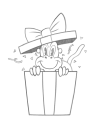In this lesson I talk in detail about reflections and what bounced light is.
Newest
@thefamangus
2mo
So basically, an understanding of the physical rules of light should help us break down and systematize everything we see while painting. As well as that, it may also help us foster a deeper appreciation for the world around us.
MAIN IDEA:
-The way light comes in and the types of materials it hits determines what kind of things happen in a scene.
>DIRECT AND INDIRECT LIGHTING (How light comes in)
-If light comes in in direct, parallel lines such as directly from the sun, the lighting will be direct with harsher shadows and brighter highlights.
-But if light comes in from many lines, such as sunlight through cloud cover, the lighting will be indirect, creating softer shadows and softer highlights.
>The three main behaviors of light particles
-Absorption
-Reflection
-And Refraction, but we didn't really talk about that much?
>The Materials the light hits change the way these behaviors manifest.
>MATERIAL PROPERTIES
-There are a lot of different ways that the material effects light, and certain properties can combine and make multilayered effects.
>Color is probably the most obvious one. When light hits and an object it will reflect and absorb into it depending on its color. When a white light hits a black object, most of the light is absorbed, the object appears dark. When a white light hits a white object, little light is absorbed and object appears brighter. When white light hits a red object, only the red light reflects off, it appears red and usually appears less bright than a white object in the same situation. (I think)
>Surface Roughness meanwhile determines *where* reflected light goes.
>Specular Surfaces are very very smooth at a microscopic level, and if light hits it, it bounces at a perfect angle. This makes things have a mirroring effect. Example: Mirror.
>Diffuse Surfaces are very rough at a microscopic level, and when light reflects off it, it scatters all around. Diffuse surfaces make dull, unreflective surfaces. For example: Bread. You will not see your reflection in bread, the surface is too rough, instead all the light which isn't absorbed is scattered all around.
>Surface Texture
-We didn't really talk about this much, but I think that the bumpy shiny ball Jeremy showed seems more like an example of texture at first than it is of surface roughness???
>Additional Properties
-Some objects have additional material properties besides color and roughness.
>Glazing, for example, is a thin layer of smooth, specular material over a usually rougher material. This certain je ne sais quoi that Jeremy will probably force use to paint at some point in this week. This is a multilayered material property.
>EFFECTS OF LIGHTING AND MATERIALS
>Diffuse Bounce light
-Often seen in enclosed spaces with a single direct light source. When a direct light comes into a space, it often hits a diffuse surface and suffuses through the room, creating diffuse lighting. You can see this if you turn off all the lights in a room while the sun shines through a window. All the light in the room is bounce light from the sun.
>Colored bounce light
-When a direct light hits a colored object, the color often ends up reflecting off other nearby objects. The video had a lot of great examples. (Colored bounce light often happens despite the underlying colors of nearby objects being different. Apparently if you blast enough colored light an object, the base color becomes overridden kind of. As Jeremy said, everything has reflections.)
>Speculars and Highlights
-Often in directly lit scenes, there are stronger highlights. If you have shiny objects, those objects often have very shiny, distinct highlights which are sometimes themselves called speculars, such as the little white bubbles that are always in cartoon character's eyes.
-On the other hand, in diffuse lit scenes, the highlights and speculars are not as pronounced.
>Reflections of the Scene in Objects
-If an object has a particularly specular (microscopically smooth/flat) surface, the scene around it will be reflected (including the light source which is how specular highlight occur). If the object is relatively colorless, the scene is often reflected in the same colors it appears to an observer. However, if the object is colored, the reflected scene will likely be tinged by these colors.
I think that's most of the stuff we went over? I mostly wrote this because I like taking notes/summarizing to remember things :)
@julia52
10d
Thanks for the summary!
Give a gift
Give a gift card for art students to use on anything in the Proko store.
Or gift this course:

About instructor
Jeremy teaches Light and Color and has worked for over 25 years in the animation, film and games industry, most notably at Pixar Animation Studios











